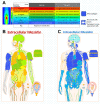Systemic evaluation and localization of resistin expression in normal human tissues by a newly developed monoclonal antibody
- PMID: 32609743
- PMCID: PMC7329134
- DOI: 10.1371/journal.pone.0235546
Systemic evaluation and localization of resistin expression in normal human tissues by a newly developed monoclonal antibody
Abstract
Resistin and resistin-like molecules are pleiotropic cytokines that are involved in inflammatory diseases. Our previous work suggested that resistin has the potential to be used as a biomarker and therapeutic target for human pulmonary arterial hypertension. However, data are limited on the distribution of resistin in healthy human organs. In this study, we used our newly developed anti-human resistin (hResistin) antibody to immunohistochemically detect the expression, localization, and intracellular/extracellular compartmentalization of hResistin in a full human tissue panel from healthy individuals. The potential cross reactivity of this monoclonal anti-hResistin IgG1 with normal human tissues also was verified. Results showed that hResistin is broadly distributed and principally localized in the cytoplasmic granules of macrophages scattered in the interstitium of most human tissues. Bone marrow hematopoietic precursor cells also exhibited hResistin signals in their cytoplasmic granules. Additionally, hResistin labeling was observed in the cytoplasm of nervous system cells. Notably, the cytokine activity of hResistin was illustrated by positively stained extracellular material in most human tissues. These data indicate that our generated antibody binds to the secreted hResistin and support its potential use for immunotherapy to reduce circulating hResistin levels in human disease. Our findings comprehensively document the basal expression patterns of hResistin protein in normal human tissues, suggest a critical role of this cytokine in normal and pathophysiologic inflammatory processes, and offer key insights for using our antibody in future pharmacokinetic studies and immunotherapeutic strategies.
Conflict of interest statement
The authors have read the journal’s policy and have the following potential competing interests: author SAP is a paid employee of Charles River Laboratories, Inc., a contract research organization that performed the immunopathological study to determine the tissue cross reactivity for the generated antihResistin antibody. The authors would like to declare the following patent applications associated with this research: RAJ had US (US 2016/0130341 A1) and international (WO 2014/204941 A1) patent applications pending for the monoclonal antibody developed against human resistin to cover pulmonary, cardiac, and other related inflammatory disorders. All other authors have declared that no competing interests exist. This does not alter our adherence to PLOS ONE policies on sharing data and materials.
Figures











Similar articles
-
Human Resistin Induces Cardiac Dysfunction in Pulmonary Hypertension.J Am Heart Assoc. 2023 Mar 21;12(6):e027621. doi: 10.1161/JAHA.122.027621. Epub 2023 Mar 16. J Am Heart Assoc. 2023. PMID: 36927008 Free PMC article.
-
Macrophage-derived human resistin is induced in multiple helminth infections and promotes inflammatory monocytes and increased parasite burden.PLoS Pathog. 2015 Jan 8;11(1):e1004579. doi: 10.1371/journal.ppat.1004579. eCollection 2015 Jan. PLoS Pathog. 2015. PMID: 25568944 Free PMC article.
-
Human resistin stimulates the pro-inflammatory cytokines TNF-alpha and IL-12 in macrophages by NF-kappaB-dependent pathway.Biochem Biophys Res Commun. 2005 Sep 9;334(4):1092-101. doi: 10.1016/j.bbrc.2005.06.202. Biochem Biophys Res Commun. 2005. PMID: 16039994
-
Role of resistin in inflammation and inflammation-related diseases.Cell Mol Immunol. 2006 Feb;3(1):29-34. Cell Mol Immunol. 2006. PMID: 16549046 Review.
-
Resistin: A reappraisal.Mech Ageing Dev. 2019 Mar;178:46-63. doi: 10.1016/j.mad.2019.01.004. Epub 2019 Jan 14. Mech Ageing Dev. 2019. PMID: 30650338 Review.
Cited by
-
Generation of a humanized afucosylated BAFF-R antibody with broad activity against human B-cell malignancies.Blood Adv. 2023 Mar 28;7(6):918-932. doi: 10.1182/bloodadvances.2022008560. Blood Adv. 2023. PMID: 36469551 Free PMC article.
-
Resistin Associated With Cytokines and Endothelial Cell Adhesion Molecules Is Related to Worse Outcome in COVID-19.Front Immunol. 2022 Jun 16;13:830061. doi: 10.3389/fimmu.2022.830061. eCollection 2022. Front Immunol. 2022. PMID: 35784283 Free PMC article.
-
Hypoxia-Induced Mitogenic Factor: A Multifunctional Protein Involved in Health and Disease.Front Cell Dev Biol. 2021 Jul 15;9:691774. doi: 10.3389/fcell.2021.691774. eCollection 2021. Front Cell Dev Biol. 2021. PMID: 34336840 Free PMC article. Review.
-
Genetic variation in the RETN promoter, accompanied by latent sarcopenic obesity, led to insulin resistance in a Japanese cohort: the Toon Genome Study.Diabetologia. 2025 Apr;68(4):854-865. doi: 10.1007/s00125-024-06322-1. Epub 2024 Dec 13. Diabetologia. 2025. PMID: 39670999 Free PMC article.
References
Publication types
MeSH terms
Substances
Grants and funding
LinkOut - more resources
Full Text Sources

